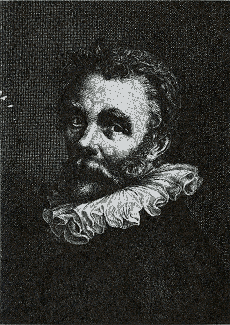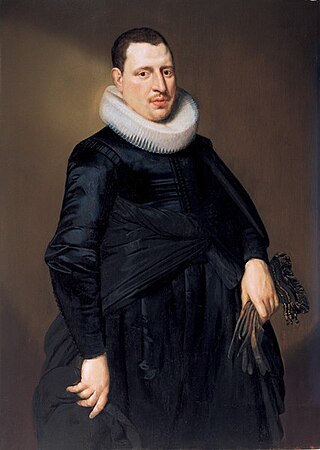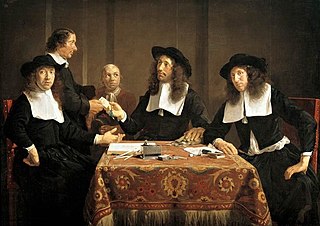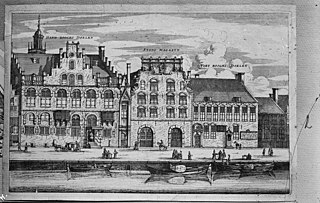
Frans Hals the Elder was a Dutch Golden Age painter. He lived and worked in Haarlem, a city in which the local authority of the day frowned on religious painting in places of worship but citizens liked to decorate their homes with works of art. Hals was highly sought after by wealthy burgher commissioners of individual, married-couple, family, and institutional-group portraits. He also painted tronies for the general market.

Bartholomeus van der Helst was a Dutch painter. Considered to be one of the leading portrait painters of the Dutch Golden Age, his elegant portraits gained him the patronage of Amsterdam's elite as well as the Stadtholder's circle. Besides portraits, van der Helst painted a few genre pictures as well as some biblical scenes and mythological subjects.

Hendrik Gerritsz Pot was a Dutch Golden Age painter, who lived and painted in Haarlem, where he was an officer of the militia, or schutterij. Dutch artist Frans Hals painted Pot in militia sash in Hals' The Officers of the St Adrian Militia Company in 1633. Pot is the man reading a book on the far right.

Schutterij refers to a voluntary city guard or citizen militia in the medieval and early modern Netherlands, intended to protect the town or city from attack and act in case of revolt or fire. Their training grounds were often on open spaces within the city, near the city walls, but, when the weather did not allow, inside a church. They are mostly grouped according to their district and to the weapon that they used: bow, crossbow or gun. Together, its members are called a Schuttersgilde, which could be roughly translated as a "shooter's guild". It is now a title applied to ceremonial shooting clubs and to the country's Olympic rifle team.

Pieter Jacobsz Codde was a Dutch painter of genre works, guardroom scenes and portraits.

Cornelis or Cornelius Ketel was a Dutch Mannerist painter, active in Elizabethan London from 1573 to 1581, and in Amsterdam till his death. Ketel, known essentially as a portrait-painter, was also a poet and orator, and from 1595 a sculptor as well.

Cornelis van der Voort or van der Voorde was a Dutch portrait painter, art collector, art appraiser and art dealer from the early 17th century who was active in Amsterdam. He painted individual portraits as well as group portraits including schuttersstukken depicting local militia members and regentenstukken depicting regents of charitable institutions, a genre of which van der Voort was the inventor. He played an important role in the development of portrait painting in the early 17th-century Dutch Republic. He is particularly noted for introducing the life-size, full-length format to Dutch portraiture.

The Banquet of the Officers of the St George Militia Company in 1616 refers to the first of several large schutterstukken painted by the Dutch painter Frans Hals for the St. George civic guard of Haarlem, and today is considered one of the main attractions of the Frans Hals Museum, Haarlem.

Banquet of the officers of the Calivermen Civic Guard, Haarlem formerly known as The Banquet of the Officers of the St Adrian Militia Company in 1627, refers to a schutterstuk painted by Frans Hals, in 1627, for the St. Adrian civic guard of Haarlem. Today it is considered one of the main attractions of the Frans Hals Museum, in Haarlem.

The Officers of the St Adrian Militia Company in 1633 refers to the second schutterstuk painted by Frans Hals for the Cluveniers, St. Adrian, or St. Hadrian civic guard of Haarlem, in 1633, and today considered one of the main attractions of the Frans Hals Museum there.

The Banquet of the Officers of the St George Militia Company is an oil-on-canvas painting by the Dutch artist Frans Hals, painted from 1626 - 1627, during the Dutch Golden Age. Today, the piece is considered one of the main attractions of the Frans Hals Museum.

The Officers of the St George Militia Company in 1639 refers to the last and largest schuttersstuk painted by Frans Hals for the St. George civic guard of Haarlem, and today is considered one of the main attractions of the Frans Hals Museum in Haarlem.

Michiel de Wael, was a Dutch brewer and citizen of Haarlem, best known today for his portraits painted by Frans Hals. His grandfather, also a brewer, was one of the first Calvinists in the city and was involved in the Siege of Haarlem.

Andries van Hoorn, or van der Horn, was a Dutch mayor of Haarlem, known best today for his portraits by Frans Hals.

Aletta Hanemans (1606–1653), was a Dutch brewer. She became the brewer of the Hoeffijser in Haarlem. She is best known today for her marriage portrait by Frans Hals, painted when she married the brewer, magistrate, and later mayor of Haarlem, Jacob Pietersz Olycan in 1624.

A regents group portrait, is a group portrait of the board of trustees, called regents or regentesses, of a charitable organization or guild. This type of group portrait was popular in Dutch Golden Age painting during the 17th century, and in the 18th century. They were intended to be hung in the regentenkamer, the regents' meeting room, or another prominent location in the institution.

Florens Pietersz van der Houff, was a magistrate and mayor of Haarlem who became a member of the Admiralty of Amsterdam during the years 1655 - 1657.

The Voetboogdoelen was a 16th-century building on the Singel canal in Amsterdam, at the corner of Heiligeweg near Koningsplein square, which served as headquarters and shooting range of the local schutterij. Frans Hals painted a group portrait for the Voetboogdoelen, known as the Meagre Company.

Portrait of a Man is an oil-on-canvas painting by the Dutch Golden Age painter Frans Hals, painted c. 1660 and now in the Frick Collection, New York City. The man has been mistakenly identified as Michiel de Ruyter.

Portrait of the Trip Sisters, also known as Portrait of Margarita Trip as Minerva Teaching Her Sister Anna Maria Trip, is an oil on canvas painting by Dutch artist Ferdinand Bol, created in 1663. It is in the collection of the Rijksmuseum, in Amsterdam, but is currently displayed at the Royal Netherlands Academy of Arts and Sciences, also in Amsterdam. It is signed and dated 'fBol 1663'.


























